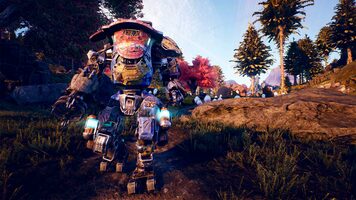
Framerate dips were constant, even with just a few NPCs on screen (not to mention the more egregious chugging that occurred during combat with multiple opponents), and there were plenty of moments where my run speed outpaced the Switch’s ability to load the map quickly enough, resulting in a “buffering” screen that I got fairly used to by the time I left the Emerald Vale. The most noteworthy issue in the three or four hours I’ve sunk into the Switch version so far is how it struggles to keep up with the onscreen action during fights, even with the downgraded textures, shadows, and lighting.
#The outer worlds board approved bundle portable
(Your results may vary – bugs, almost by definition, don’t affect everybody equally.) Update: How Does The Outer Worlds Work on Switch? By Jon Ryan, JLike so many ports before it, The Outer Worlds’ Switch version packs as much of the original experience as it can into a hand-held package, but taking a game designed for the Xbox One and PlayStation 4 to the lighter and portable hardware means there are some noticeable technical shortcomings. I’ve only had one temporarily broken side quest (where I couldn’t turn it in to the questgiver for a while) in more than 30 hours – other than that it’s been extremely smooth.
#The outer worlds board approved bundle Pc
Especially since the rushed development of Fallout: New Vegas, Obsidian has carried around a reputation for games being buggy at launch, but if my experience playing through The Outer Worlds on PC is any indication it might be the game to change that perception. The nice thing about it is that losing some reputation is a somewhat meaningful consequence for getting caught stealing people’s trinkets other than a potentially game-ending fight with security or everything grinding to a halt while you break out of jail for the eighth time. Accordingly, there’s a faction reputation system in play that keeps track of who you’ve helped or wronged, but it never really felt important because for the most part its only rewards are discounts of up to 25% at vendors, and using vendors is rarely necessary. Those all result in the same outcome if your skill is high enough to enable the dialogue options (which are labeled to indicate which one is being used, as in Fallout: New Vegas) but it lets you have a say in whether your character plays the role of scoundrel, diplomat, or thug. “It’s a very familiar format to anybody who’s played a Fallout game, in that there are almost always multiple ways to fight, talk, or sneak your way through – and notably there are different speech skills to lie, persuade, or intimidate your way past adversaries. The Outer Worlds feels smaller in scale than that, though, so that works well enough. The first big quest has major parallels to Fallout 3’s signature Megaton choice, though while I did enjoy hearing about the philosophical differences between various factions, there aren’t many big surprises or Megaton-like “wow” moments in how quests play out. Sometimes by throwing a switch to declare your preference for the winners, and sometimes by simply shooting said losers. On one hand, The Outer Worlds feels aimless for a long time, but on the other, that means the quest to help a mad-ish scientist revive your fellow colonists from hibernation sort of fades into the background as you casually wander into the middle of morally gray local conflicts and pick winners and losers. In some ways it’s nice that the story doesn’t put a face on the evil corporate Board that rules over this isolated colony until around two thirds of the way through the roughly 30-hour campaign – and even when they do they’re not all that menacing. It isn’t hard to picture Captain Malcolm Reynolds reading off some of the more sarcastic dialogue options, either. From the on-the-nose “Firefly” branding on the energy weapon ammo to the fact that your junky transport’s young naive engineer lady talks pretty much exactly like Kaylee, it’s layered on thick in a way I appreciated.

And, as a big fan of the short-lived sci-fi western show Firefly, I spotted its influences everywhere.


Everywhere you look there’s a satirical slogan or crazy-eyed mascot, a worker being treated as hilariously disposable, and oppressive propaganda and policies keeping everybody in line. I wouldn’t quite call this space-frontier themed adventure the best of both, but it’s a creative and well-made take that’s both familiar and new all at once.The Outer Worlds takes place in a solar system-wide colony ruled by corporate feudalism and filled with dark humor. Obsidian, a developer that’s made sequels to both BioWare’s Star Wars: Knights of the Old Republic and Bethesda’s Fallout 3, has merged those two distinctive flavors, and they taste great together. The Outer Worlds is the “you got chocolate in my peanut butter” of RPGs.


 0 kommentar(er)
0 kommentar(er)
